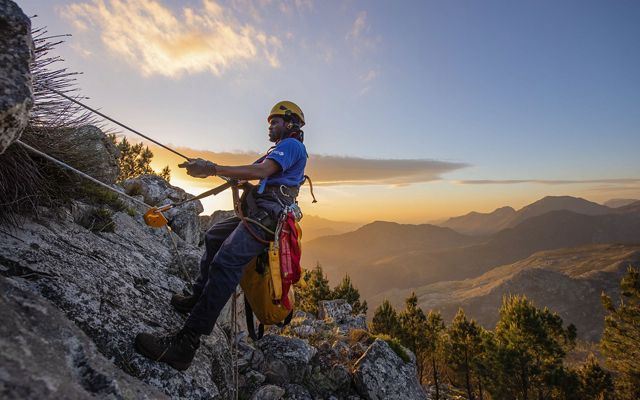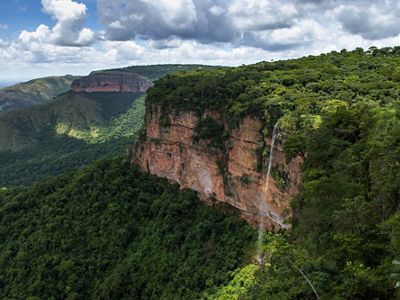Nature-Based Solutions for Resilient Watersheds
Climate change is worsening the water crisis, but nature can help us adapt—if we act now.
Daniel Shemie, Strategy Director, Resilient Watersheds
Few people today need to be reminded that we will feel the effects of climate change through water. That’s because a growing number of us already have firsthand experience living through a record-breaking storm, flood or drought. People in Cape Town, South Africa, became keenly aware of how climate affects water when rainfall dropped to record lows in 2017. As reservoir levels dropped, citizens waited in lines for water and saved buckets from their short showers to flush the toilet. Nearby farmers who share a common water source with the city certainly could not ignore the economic toll of the drought as their crops failed. Nor could the estimated 30,000 farmhands who lost their jobs.
Those of us hoping for a greener and more inclusive recovery from the global pandemic would do well to pay attention to Cape Town’s response to this water crisis. Alongside major investment in new wells and desalination plants, the city increased its investment in nature. Specifically, in the restoration of native fynbos shrublands known for their exceptional degree of biodiversity and relatively low water consumption.


Braving the elements at high altitudes, specialized teams have cleared 19,000 hectares (47,000 acres) of thirsty invasive plants and reclaimed 9,040 billion liters of water in the process for the drought-prone city. A recent 62 million rand ($US4.2 million) investment from Cape Town’s City Council—matched rand for rand by contribution from the private sector and others—will help the local watershed coalition triple the area restored and in so doing, reclaim the equivalent of two months’ worth of water supply. Critically, restored areas must be kept free of invasive trees to maintain those gains, especially as most global climate models predict lower rainfall for the Cape Town region.
Many countries are now on the cusp of once-in-a-generation infrastructure investments. Traditionally in the water sector this equates to levees, dams, pipes, treatment plants, and sewage systems. For a growing number of governments and companies, however, investing in water now includes nature-based infrastructure like forests and wetlands to make those built systems more resilient. Pairing green with gray is a big step forward for decades of science that underscores the importance of nature in delivering clean water and reducing floods and landslides.
For the growing number of us concerned with adapting to a changing climate, it’s time to take an interest in the watersheds where our water comes from and what can be done to protect them.

Nature-based solutions: The challenge—and the opportunity
Our watersheds—the lands around rivers, lakes and streams—are some of the hardest working and most undervalued natural systems on Earth. For all they do to support our planet and our lives, watersheds are in trouble. Today, nearly half of all drinking water sources are significantly degraded. Deforestation, poor agricultural practices, illegal mining and unchecked urban development are rapidly altering these landscapes and, in doing so, killing our rivers. Since 1970, there’s been an 84% decline in freshwater species populations driven in part by the steady degradation of watersheds, as well as the widespread damming and diverting of free-flowing rivers. This death by a thousand cuts has led to the collapse of freshwater ecosystems, which in turn contribute to more severe droughts and floods.
But conserving our watersheds is not only urgent, it’s very achievable.
At the local level, as we’ve seen in Cape Town, it starts with valuing healthy watersheds, and then agreeing to work together to conserve them at a material scale. From New York to Quito to Beijing, there are landmark collective agreements to do just that. Many more forward-looking businesses, governments and water utility companies are asking how nature-based solutions can help them adapt to a changing a climate.
However, they are finding that even where the benefits of investing in nature are outsized, raising the necessary financial and political capital to implement nature-based solutions across a watershed can be painstaking interdisciplinary work. Indeed, it sometimes requires an imminent crisis to spur action. Fortunately, there are partners they can turn to for help, including The Nature Conservancy (TNC).
Protecting one watershed at a time, however, will only get us so far so fast. Today less than 1% of water sector investments go towards nature-based solutions. Much more is needed to meet the urgency and scale of the challenge and to ensure nature-based solutions are central to how we achieve water security in a changing climate.

To solve the water & climate challenge, dream bigger
To adapt to a changing climate, water users and operators urgently need to re-examine their relationship to water resources and invest in nature-based solutions. This requires demonstration projects, but also more immediate action to solve demand and supply-side market failures. TNC is working with partners to spur this paradigm shift through a multi-faceted approach.
1. Demonstrate nature-based solutions work on the ground
TNC is involved in nearly 50 watershed investment programs that employ nature-based solutions to address a range of challenges, including living with wildfires, mitigating flooding, increasing water quality and dry season availability, and improving market access for farmers and ranchers.
An excellent example can readily be found in the western United States, where too little water, including recent declines in rainfall and snowpack, is worsening a long-standing water and wildfire problem. Fires in the basin not only scorch the region’s iconic conifer forests but choke waterways that supply drinking water to half of New Mexico’s population with ash and sediment.
New Mexico’s Rio Grande Water Fund has some 95 signatory partners, and since 2014 has worked collaboratively to conduct controlled burns on over 140,000 acres to thin underbrush that would otherwise fuel flames. The icing on the cake: investments in this nature-based solution not only maintain habitat and water supply but have supported small business and rural economies to the tune of $120 million in economic impact.
Individually, these place-based projects deliver a stack of climate, biodiversity and livelihood outcomes. In aggregate, they’ve come to serve as a learning laboratory and generated troves of evidence and lessons.
Quote
Today less than <1% of water sector investments go towards nature-based solutions.
2. Equip partners with training, tools and technical support to succeed
As demand for nature-based solutions has grown, we have increased our focus on equipping partners. For the last five years, this has included a mix of technical assistance and trainings that introduce the concept of nature-based solutions and, subsequently, train partners on how to design and operate their own watershed investment programs. We’ve trained well over 500 practitioners in the last year alone, including tailored trainings for corporate partners whose value-chains reach every corner of the world. By tailoring training to AB InBev employees, for example, our corporate partners can deliver on the promise of their sustainability goals and ensure those efforts have tangible, lasting impacts.
Beyond training, we are rolling out new tools in field programs that show promise for wider adoption. This November we’ll launch WaterProof, which will be able to calculate a return-on-investment (ROI) for nature-based solution portfolios and drastically reduce the cost and time needed to make a go or no-go decision on investing in nature.
Once a project has proven to be a strong investment, we then work with partners to develop a Decision Support System (DSS) to bring transparency over who’s doing what and where. It’s common for several organizations to work in the same watershed, and the DSS helps stakeholders work together to ensure they’re complementing each other’s work and implementing the highest impact projects.


3. Increase investment in nature-based solutions and remove barriers for their adoption
Despite growing interest in nature-based solutions, companies and water providers often discover they don’t have the remit to invest in the watersheds where they operate. This is particularly salient for water utilities who have a directive to supply water to customers in the most cost-effective way. If regulation only permits traditional built infrastructure, the utility’s options for potential investment are limited.
Brazil is on the leading edge of updating regulation to allow water providers to invest in nature-based solutions. For example, a recent return-on-investment analysis of the Water Producer Program in Camboriú, Santa Catarina helped spur the state’s regulatory agency to permit watershed investments in water tariffs. This decision impacts cities across the entire state, and regulatory agencies in Minas Gerais State and the Federal District have also moved to replicate this structure. Securing sustainable funding, like tariffs, for conservation can also help mobilize the repayable financing needed to cover high upfront costs of large-scale restoration efforts. That’s why we’re also working together with investment banks—including the Inter-American Development Bank (IDB) and the Agence Française de Development (AFD)—to help build a pipeline of investment-ready nature-based solutions programs.
While regulation changes can impact hundreds of watersheds, commitments by multi-national corporations to invest in nature-based solutions across their value chains can impact thousands. Fortunately, more and more companies are interested in investing in nature as a cost-effective means of achieving their operational and sustainable water targets and see nature-based solutions as a means to achieve other important co-benefits, like climate mitigation and adaptation. In fact, many companies are helping advance the science on the benefits of NBS, and are often early mover investors in collective action programs. In fact, both Coca-Cola and Pepsi were early investors in the São Paulo and Cape Town watershed investment programs, despite being fierce rivals in the marketplace. Over 100 companies have invested $60 million plus in TNC’s Resilient Watershed programs to date, but corporations usually cannot provide the magnitude of capital needed to anchor a watershed investment program; more is needed from big spenders—like utilities—to sustain these programs long-term.
Quote
To adapt to a changing climate, water users and operators urgently need to re-examine their relationship to water resources and invest in nature-based solutions.
We’re running out of time to protect our rivers and watersheds, but there’s plenty of reason for hope. Countries around the world stand on the precipice of passing once-in-a-generation infrastructure investments that could forever change the way natural infrastructure—like forests, floodplains and wetlands—is valued by society. Private companies too are increasing their investments in nature to address their water security needs. And both are preparing this fall for some of the most consequential climate and biodiversity negotiations of the decade. Fortunately, we know what to do. We need to protect, restore, and invest in our watersheds and upstream communities—we need nature now.
Global Insights
Check out our latest thinking and real-world solutions to some of the most complex challenges facing people and the planet today.



